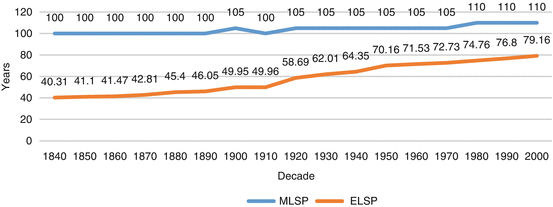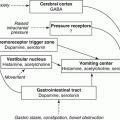Fig. 1.1
Death and survival in the United States in 2005 (Skinner 2009)
Skinner’s data from 2005 had a doubling of the death rate every 8 years, just as did Gompertz’ in 1825. That is not to say life expectancy has not changed. Figure 1.2 shows the life expectancy in Britain over the last 450 years, and there has been a marked increase in life expectancy, from 41 years in 1840 to 79 years in 2010. However, the rate of change of the curve has held constant. What is also clear from the data in Fig. 1.2 is that the maximum life span has changed very little over 160 years, despite the dramatic improvement in expected life span. The maximal life span was taken to be the age when less than three standard deviations of the population were alive, that is, less than 0.27 % of the population born in the reference period was still alive.


Fig. 1.2
Life expectancy and maximum life span in Britain 1840–2010 (Data are from the human mortality database (http://www.mortality.org/)
Gompertz’ equation is from line fitting the data and is not explanatory. Why is man designed to die? Why has not natural selection directed us to immortality? Attempts have been made to explain the underlying mechanisms of aging and, ultimately, death. There are three types of explanations. One is an overall theory about the inevitability of aging without specifics as to causes. An example is the utilization of Information Theory and the Second Law of Thermodynamics. The Second Law of Thermodynamics states that entropy (i.e., the randomness of a system) is always increasing (Riggs 1993). As described by Riggs, the entropy that is increasing in the cell and leading to death is an increase in informational entropy of the genome. The informational order in the genome is due to genomic redundancy (the genome has a lot of redundancy, and therefore it has low informational entropy). As people, and more specifically the cells of people, age, there is a rate of error during cell division which causes increased randomness of information and increased entropy, ultimately leading to death. The same approach, but on a more direct causal level, was developed by Bolt and Bergman under the somewhat heavy-handed acronym BOLT (Burn Out Lifespan and Thermosensitivity) (Bolt and Bergman 2015). In their approach, they utilize a systems biology model centered on the sensitivity of proteins to slight variations in temperature, and the resultant loss of redundancy of important proteins leads to aging effects. “To review, BOLT theory suggests that minor fluctuations in thermal energy are the antagonizing agents of age-related changes that result in functional decline. In network terms, we can say that heat alters the properties of nodes (biomolecules) or hubs (highly connected biomolecules) such that the edges (the nature of interactions) between them are modified and topological changes to network architecture allow new properties to emerge.” Further, “We can think of a phenotype as the path taken by a ball rolling down that {epigenetic] landscape. Just as in energetics, the ball will follow negative gradients: often moving through narrow canals formed by closely related by relatively unfavorable options. To alter the scaffold and landscape is to alter the route a ball will take and thus an individual’s phenotype. The BOLT theory suggests that thermal energy warps the scaffold to elicit different phenotypic outputs” (Bolt and Bergman 2015). This strongly suggests the entropic/heat model of the Second Law of Thermodynamics, and thus evokes the Informational Entropy theory of Riggs.
Another explanatory approach to the cause of aging that has had long-term popularity and a reasonable amount of supporting experimental data is that aging is a function of free radical formation within cells (Perez-Campo et al. 1998). In particular, the formation of free radicals in the mitochondria is at the heart of aging. Early studies suggested that the level of antioxidants correlated with maximal life span. Further studies found that maximal life span correlated better with mitochondrial fee radical formation rate, suggesting that the immediate damage was more important than the ability to detoxify the free radicals (Perez-Campo et al. 1998). There are many other models of aging, but no definitive answer as to the underlying process (DiLoreto and Murphy 2015).
Aging and cancer are mechanistically related. Many of the processes of aging (senescence) are the same processes that lead to the development of cancer (Finkel et al. 2007; Loaiza and Demaria 2016; Serrano and Blasco 2007). As discussed in the chapter on Programmed Cell Death, cells normally stop growing, and ultimately die. Those cells that lose the ability to die become tumor cells. The common term used in the laboratory for cells that continue to grow is “immortal.” Thus, normal cells, such as fetal fibroblasts, may grow in cell culture for a time, but ultimately, after about 50 divisions, they die. This was first noted by Hayflick and Moorhead in 1961 (Hayflick and Moorhead 1961). The first immortal cell line was developed by George and Martha Gey from the cervical cancer of Henrietta Lacks, the HeLa cells (Scherer et al. 1953). Although Henrietta Lack’s cancer cells are immortal, she unfortunately died 8 months after her diagnosis (Finkel et al. 2007). The difference between the eternal growth patterns of cancer cell lines and limited growth of normal cell lines suggests that cell senescence can lead to either of two endpoints: the planned outcome of cell death or the more catastrophic outcome of cancer.
If death is universal, why does it evoke such fear? Some level of death anxiety is part of the human condition. It is doubtful that any other animal has sufficient self-awareness to be able to imagine its own death. In Ancient Greek mythology, it was stated that one of the greatest gifts of Prometheus to man was that he took away the foreknowledge of the time of each person’s death. As Aeschylus wrote in the fifth century BCE:
“Chorus: Did you perhaps transgress even somewhat beyond this offence? Prometheus: Yes, I caused mortals to cease foreseeing their doom (moros).
Chorus: Of what sort was the cure that you found for this affliction?
Prometheus: I caused blind hopes (elpides) to dwell within their breasts
Chorus: A great benefit was this you gave to mortals.” (Smyth 1926)
Freud stated that people do not fear death because they have not and cannot experience death. Rather, the fear of death is a representation of another unconscious fear, such as abandonment (Drobot 2015). However, the fear of death (thantophobia) is now often considered a psychological driving force. The most utilized of the current theories on the psychological response to death anxiety is terror management theory (TMT). In TMT, an individual faced directly or indirectly with death (i.e., the death of themselves or others) aim for cultural worldview validation by showing that their core beliefs are correct and culturally accepted and enhanced self-esteem by showing others that they represent these worldviews well. The identification with the culture gives them a feeling that they will have continuity after death through this culture.
The central premise of this theory is that people have developed two defense mechanisms, namely cultural worldview validation and self-esteem enhancement, in an effort to avoid the terror associated with death. The former defense consists of symbolic social constructions that provide a sense of meaning, order, and permanence. High self-esteem is achieved when an individual believes that he or she meets culturally prescribed standards of value. (Mosher and Danoff-Berg 2007)Stay updated, free articles. Join our Telegram channel

Full access? Get Clinical Tree





